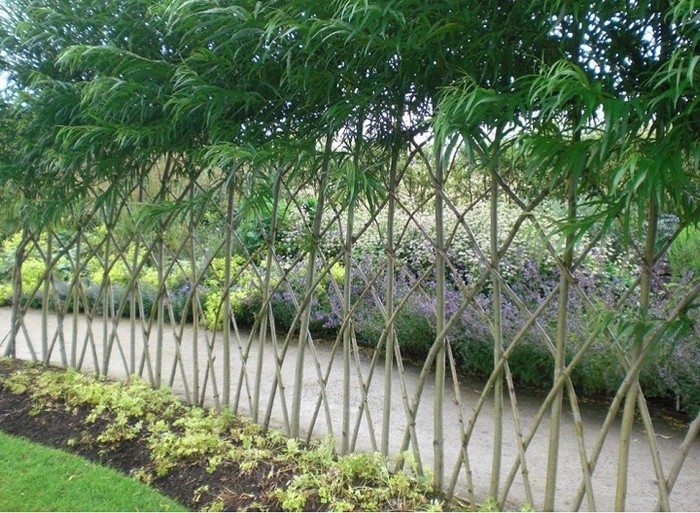
Are you looking for a decorative way to demarcate your yard or property? A living willow fence is a great option! It’s a beautiful solution if you need some level of privacy in your yard or if you want to separate certain areas in your property.
Living willow fences are also called willow hedges, but the more popular British term for them is “fedges” – the combination of a fence and a hedge. This type of fencing idea is most common in Europe as willows are native to the temperate climate and moist soils in the Northern Hemisphere.
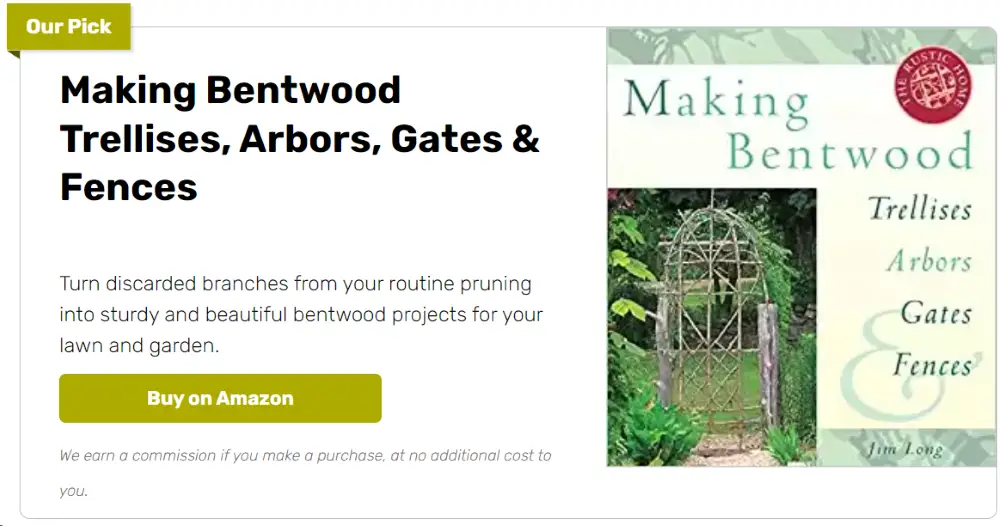
There are many different ways or styles of living willow fences but they are all easy to make. The most common you will find have diagonal patterns.
Some people use cable ties to form or arrange withies and whips, but the better idea is to use elastic bands. This way the willows can grow but still maintain their form since the ties adjust/stretch as the stems grow.

Now although a living willow fence is easy to make, there’s one important thing to consider if it is indeed a good solution for you. And that is the location. Since their roots tend to grow larger than the stems that grow from them, and they tend to crawl towards bodies of water, you should avoid building a living willow fence near septic or water lines.
If this will not be a concern in your situation, then start gathering willow cuttings and enjoy building your very own fedge! And remember that this fence needs to be pruned at least twice a year, especially if you want the pattern/design to show. ;)
Contents
Why Choose Living Willow Fences
Here are some reasons why you should have a living wall fence:
1. Natural Aesthetic: Living willow fences provide a beautiful and natural aesthetic to outdoor spaces. Their lush green foliage and graceful arching branches add charm and character to gardens, creating a visually appealing backdrop for plants and flowers.
2. Privacy and Screening: As the willow branches grow and intertwine, they create a dense barrier that offers privacy and screening from neighbouring properties or unsightly views. This natural barrier can help to define boundaries and create secluded areas within the garden.
3. Wildlife Habitat: willow fences provide valuable habitat for wildlife, including birds, insects, and small mammals. The dense foliage and branching structure offer shelter, nesting sites, and foraging opportunities, contributing to biodiversity in the garden.
5. Eco-Friendly: Willow is a fast-growing and renewable material, making willow fences an eco-friendly choice for garden fencing. Unlike traditional fences made from non-renewable materials such as wood or metal, living willow fences can be sustainably harvested and regrown, reducing environmental impact.
6. Low Maintenance: Once established, living willow fences require minimal maintenance compared to traditional fences. Regular pruning may be necessary to maintain shape and density, but otherwise, they require little attention. Willow is also resistant to pests and diseases, further reducing the need for chemical treatments.
7. Flexible Design: Flexible Design: willow fences offer flexibility in design, allowing for curved or irregular shapes to suit the contours of the landscape. They can be easily customized to fit specific space requirements and architectural styles, providing endless design possibilities for gardeners and landscapers.
Whether you prefer a flowing, organic look or a more structured and geometric design, willow fences can be shaped and sculpted to match your vision. This versatility allows you to create unique and eye-catching features that enhance the beauty and functionality of your outdoor space.
Additionally, the natural texture and colour of the willow branches add a rustic charm to any garden or landscape design, creating a seamless transition between the built environment and the surrounding natural elements.
Overall, living willow fences offer a sustainable, attractive, and wildlife-friendly alternative to traditional fencing options, making them a popular choice for gardeners seeking to enhance their outdoor spaces.
Need ideas? Have a look at some examples we have for your below!
Click on any image to start the lightbox display. Use your Esc key to close the lightbox ![]()
Stunning Living Willow Fences
Diamond Pattern
The diamond pattern adds a distinctive and elegant look to the fence, creating visual interest and enhancing the overall appearance of your garden or landscape.
Like all living willow fences, a diamond pattern fence provides a natural and organic beauty to your outdoor space. The lush green foliage and graceful arching branches create a soothing and tranquil atmosphere, perfect for relaxation and enjoyment.
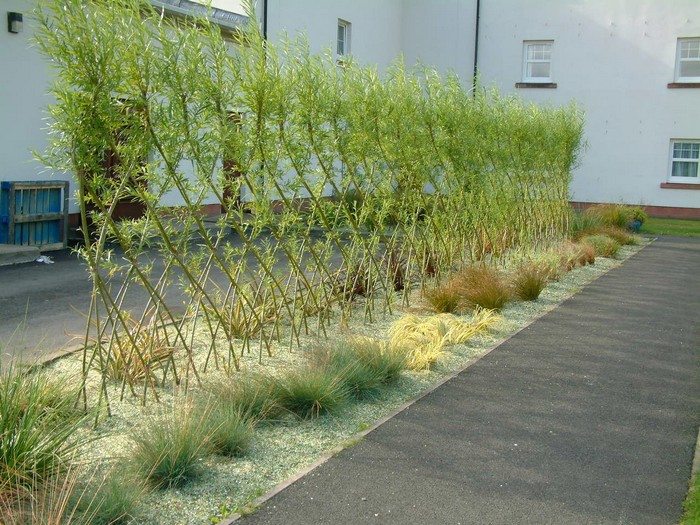
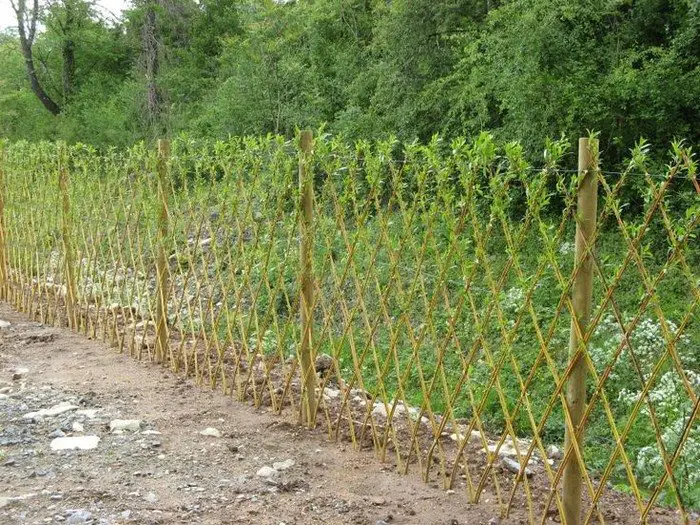
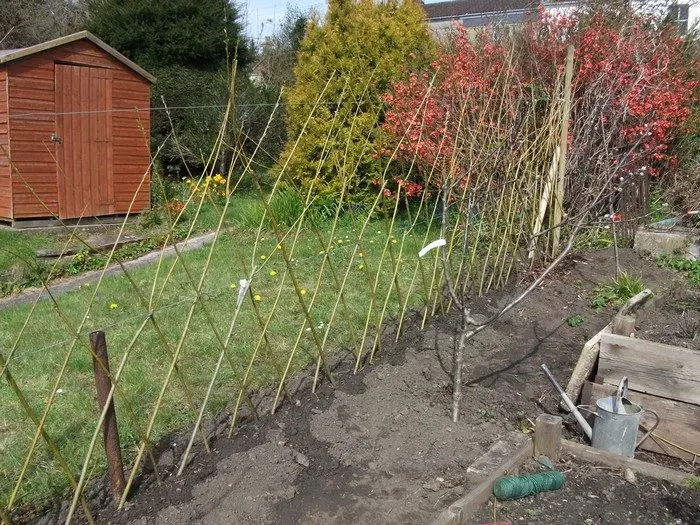
Diamond Pattern with Horizontal Weaves
The diamond pattern with horizontal weaves allows for customization to suit your preferences and space requirements. You can adjust the spacing of the horizontal weaves or vary the size of the diamond pattern to create a unique and personalized look for your fence.
Living willow fences are environmentally friendly and sustainable. Willow is a fast-growing renewable resource, and the living fence provides habitat for wildlife, improves soil health, and contributes to biodiversity in your garden
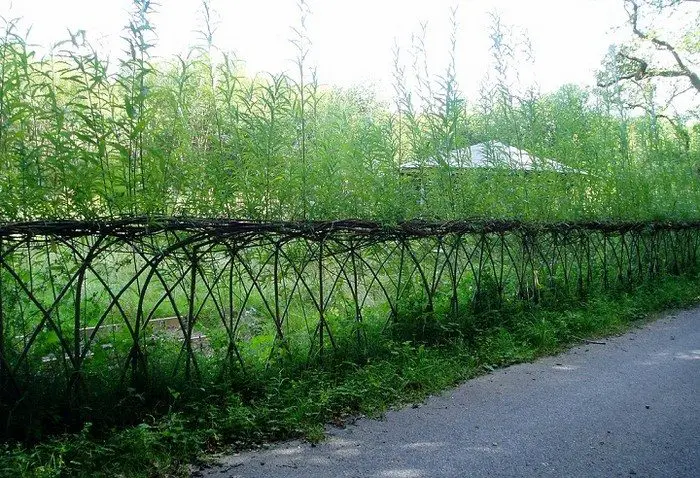

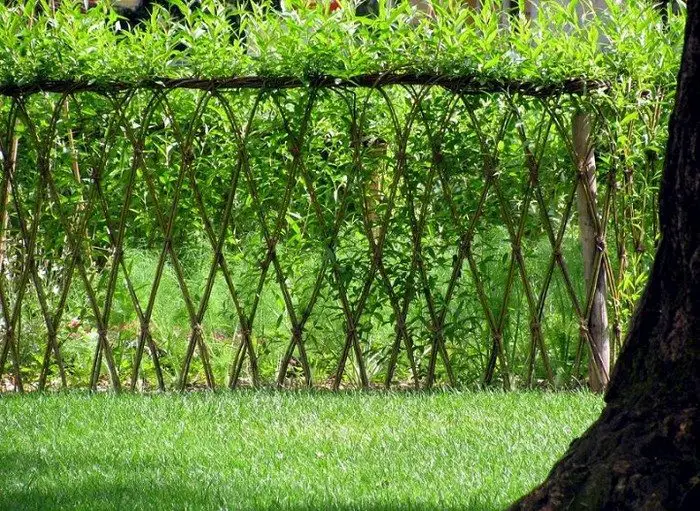
Diamond Pattern with Vertical Uprights
The combination of vertical uprights with the diamond pattern adds strength and stability to the fence structure. The vertical branches provide additional support, preventing sagging or shifting over time and ensuring the longevity of the fence.
The juxtaposition of the diamond pattern with vertical uprights creates a visually interesting and distinctive design. This intricate pattern adds depth and texture to the fence, making it a standout feature in your garden or landscape.
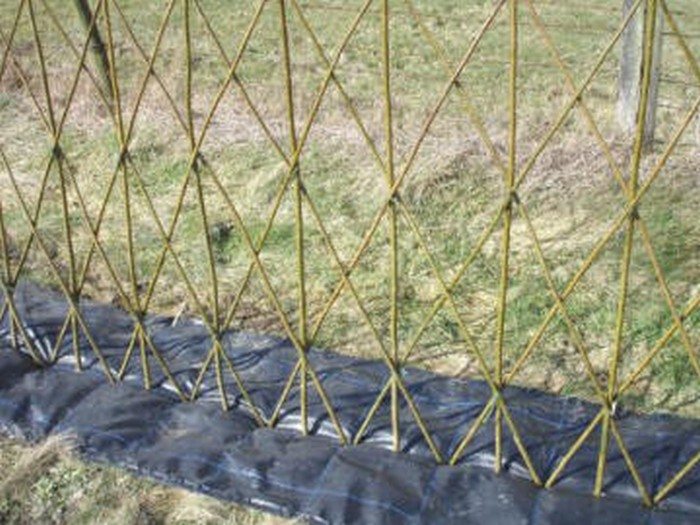

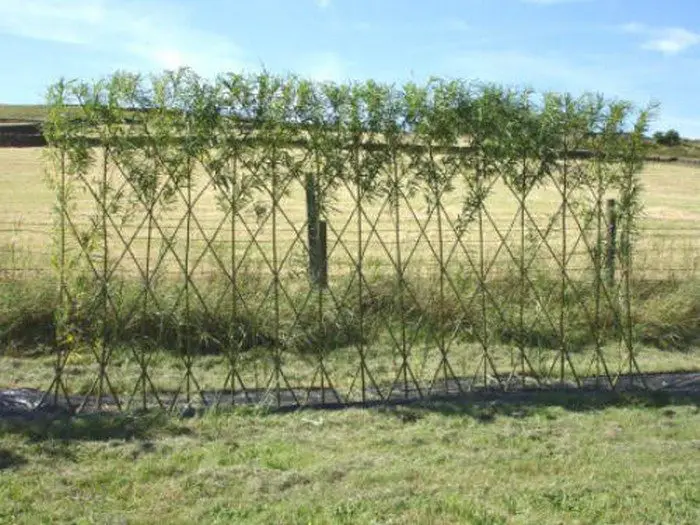
Vertical
Vertical elements such as upright branches or stakes provide additional reinforcement to the fence structure, improving its stability and strength. This helps prevent sagging or leaning over time, ensuring the fence remains robust and durable.
The combination of vertical elements with the diamond pattern creates an eye-catching and unique design. The contrast between the vertical lines and the diagonal diamond shapes adds depth and visual interest to the fence, making it a focal point in your garden or landscape.


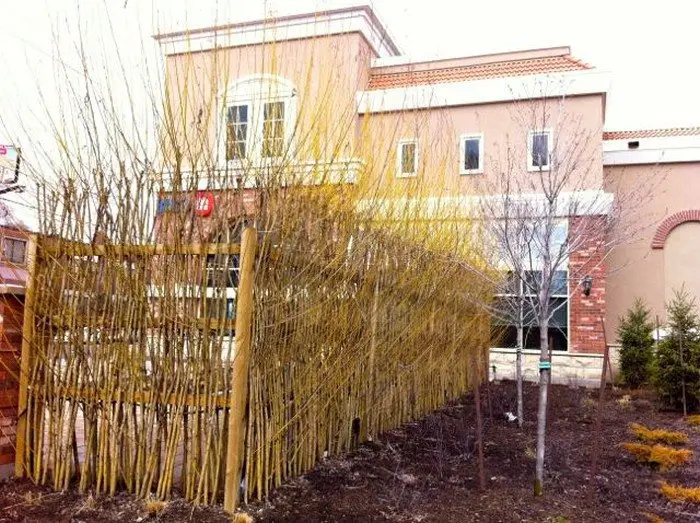
Perfecting Your Living Willow Fence with Pro Tips
Creating a living wall fence can be a rewarding project that adds beauty and functionality to your outdoor space. Here are some tips to help you plan and execute your living wall fence:
1. Choose Suitable Plants: When selecting plants for your living wall fence, prioritize those that are adept at thriving in vertical gardening environments. Take into account key factors like sunlight exposure, soil moisture levels, and climate conditions to ensure optimal growth.
Aim for a diverse selection of plants, incorporating trailing varieties for cascading beauty, compact plants for lush foliage, and upright species to add structure and depth. This mix will not only enhance visual appeal but also contribute to a balanced and thriving ecosystem within your living wall.
2. Prepare the Wall Surface: Before installing your living wall fence, it’s crucial to properly prepare the wall surface to ensure stability and longevity. Start by thoroughly cleaning the wall surface, and removing any dirt, debris, or existing vegetation. Inspect the wall for any cracks or damage, and repair them as necessary to prevent structural issues down the line.
Additionally, consider applying a waterproof membrane to the wall surface to safeguard against moisture damage, especially if the wall is exposed to rain or irrigation. This protective layer will help maintain the integrity of the wall and prolong the lifespan of your living wall fence.
3. Install Proper Irrigation: Proper irrigation is essential for the health and vitality of your living wall fence. Consider installing a drip irrigation system to deliver water directly to the plant’s roots and ensure even moisture distribution. Alternatively, hand watering or a self-watering system can also be effective.
4. Provide Adequate Drainage: Ensure that your living wall fence has proper drainage to prevent waterlogged soil and root rot. Use a well-draining growing medium and incorporate drainage holes or channels into the design to allow excess water to escape.
6. Monitor Plant Health: Regularly inspect your living wall fence for any indications of pests, diseases, or nutrient deficiencies. Conduct thorough examinations of the foliage to detect any abnormalities such as discolouration, wilting, or unusual growth patterns. Keep an eye out for signs of pest activity, such as chewed leaves or webs.
Additionally, observe the overall health and vitality of the plants in your living wall. If you notice any issues, take immediate action to address them to prevent further spread and ensure the continued well-being of your greenery. By staying vigilant and proactive, you can maintain a thriving and beautiful living wall fence.
6. Prune and Maintain: Regular pruning is essential for keeping your living wall fence in top condition. Trim away any dead, damaged, or overgrown foliage to promote healthy growth and maintain the aesthetic appeal of your greenery. Use sharp and clean pruning shears to make precise cuts, ensuring minimal stress to the plants. Additionally, fertilize your plants periodically with a balanced fertilizer to replenish essential nutrients and support vigorous growth.
Follow the manufacturer’s instructions for application rates and timing to avoid over-fertilization. By incorporating regular pruning and fertilization into your maintenance routine, you can ensure that your living wall fence thrives and remains visually stunning for years to come.
7. Consider Maintenance Needs: Keep in mind the maintenance requirements of your living wall fence when choosing plant species and designing the layout. Select plants that are low-maintenance and can tolerate occasional neglect if necessary.
8. Enjoy Your Living Wall: Once your living wall fence is established, take the time to enjoy its beauty and benefits. Spend time relaxing in your outdoor space and appreciate the vibrant greenery and natural beauty of your living wall fence.
The Wrap Up
Living willow fences offer a unique and eco-friendly way to enhance your outdoor space while providing privacy, beauty, and habitat for wildlife. Whether you opt for a diamond pattern, horizontal weaves, or vertical uprights, these living structures bring a touch of natural elegance to any garden or landscape.
With their versatility, sustainability, and aesthetic appeal, willow fences are not just functional barriers but also living works of art that evolve and flourish over time. Embrace the beauty of nature and create your own stunning willow fence to transform your outdoor environment into a tranquil oasis.
FAQ: Living Willow Fence
1. What exactly is a living willow fence, and how does it differ from traditional fencing methods?
A living willow fence is a type of fence constructed by weaving live willow branches or cuttings into a fence structure. Unlike traditional fences made from non-living materials like wood or metal, willow fences incorporate living plants, which grow and form a dense barrier over time.
While willow fences may not offer the same level of immediate privacy and security as solid barriers like wooden or metal fences, they can provide a natural and visually appealing privacy screen over time. Their dense growth and height can help create a sense of privacy and deter unwanted intrusions.
2. What are the advantages of choosing a living willow fence over other types of fences?
Living willow fences offer several advantages, including their natural beauty, sustainability, and ability to provide habitat for wildlife.
The dense foliage and intricate branching patterns of willow plants create shelter and nesting opportunities for various birds, insects, and small mammals. By fostering biodiversity, willow fences contribute to the overall health and balance of local ecosystems.
Additionally, willow fences offer air-purifying qualities, helping to improve air quality in their vicinity. Like all plants, willows absorb carbon dioxide and release oxygen during photosynthesis, effectively filtering pollutants from the air. This natural air filtration process can help create a healthier and more breathable environment around the fence.
3. How long does it typically take for a living willow fence to grow and become established?
The time it takes for a willow fence to grow and become established can vary depending on factors such as climate, soil conditions, and willow species. Generally, it may take several growing seasons for the fence to fully establish and achieve its desired density.
4. Are living willow fences suitable for all climates and environments?
willow fences can thrive in a wide range of climates and environments, from temperate to subtropical regions. However, factors such as sunlight exposure, soil moisture, and winter temperatures can influence their growth and health.
The species of willow used in the fence can also affect the establishment timeline. Some willow varieties are known for their rapid growth and vigorous rooting, while others may grow more slowly. Selecting appropriate willow species suited to the local climate and soil conditions can optimize growth and shorten the establishment period.
Typically, a living willow fence will show noticeable growth and density within the first year of planting. However, it may take two to three years or more for the fence to reach its full height and thickness, depending on the aforementioned factors. Regular maintenance, such as pruning and watering, can help expedite growth and ensure optimal establishment of the living willow fence.
5. What factors should you consider before installing a living willow fence in your garden or property?
Before installing a living willow fence, consider factors such as available space, soil drainage, sunlight exposure, and potential interference with underground utilities.
Before proceeding with the installation of the living willow fence, identify any underground utilities that may be present in the area. Common utilities include water pipes, electrical lines, gas pipelines, and sewer lines. Use caution when digging or planting near these utilities to avoid damaging them accidentally.
Contact your local utility providers to request utility locates or markings to help identify the precise locations of underground utilities before beginning any excavation work.
6. Can living willow fences provide sufficient privacy and security, especially compared to conventional fences?
While living willow fences may not offer the same level of immediate privacy and security as solid barriers like wooden or metal fences, they can provide a natural and visually appealing privacy screen over time. Their dense growth and height can help create a sense of privacy and deter unwanted intrusions.
7. What are the maintenance requirements for a living willow fence, and how do they differ from traditional fences?
Maintenance for a living willow fence typically involves periodic pruning, watering during dry periods, and occasional fertilization. Unlike traditional fences that may require staining or painting, willow fences benefit from regular trimming to promote healthy growth and maintain their shape.
Keep the area around the base of the willow fence free from weeds and competing vegetation that can compete with the willow plants for water, nutrients, and sunlight. Use mulch or landscape fabric to suppress weed growth and retain soil moisture, but avoid placing mulch directly against the stems of the willow plants, as it can create conditions favourable for fungal diseases. Regularly remove any weeds that do emerge to prevent them from establishing a foothold in the area.





